
![]()

![]()
The art of ancient Greece has exercised an enormous influence on the culture of many countries from ancient times until the present, particularly in the areas of sculpture and architecture. In the West, the art of the Roman Empire was largely derived from Greek models.
In the East, Alexander the Great's conquests initiated several centuries of exchange between Greek, Central Asian and Indian cultures, resulting in Greco-Buddhist art, with ramifications as far as Japan. Following the Renaissance in Europe, the humanist aesthetic and the high technical standards of Greek art inspired generations of European artists. Well into the 19th century, the classical tradition derived from Greece dominated the art of the western world.
Art historians generally define Ancient Greek art as the art produced in the Greek-speaking world from about 1000 BC to about 100 BC. They generally exclude the art of the Mycenaean and Minoan civilizations, which flourished from about 1500 to about 1200 BC. Despite the fact that these were Greek-speaking cultures, there is little or no continuity between the art of these civilizations and later Greek art.
At the other end of the time-scale, art historians generally hold that Ancient Greek art as a distinct culture ended with the establishment of Roman rule over the Greek-speaking world in about 100 BC.
After this date they argue, Greco-Roman art, though often impressive in scale, was largely derivative of earlier Greek models, and declined steadily in quality until the advent of Christianity brought the classical tradition to an end in the 5th century AD.
There is also a question relating to the word "art" in Ancient Greece.
The Ancient Greek word 'tekhni', which is commonly translated as "art," more accurately means "skill" or "craftsmanship" (the English word "technique" derives from it). Greek painters and sculptors were craftsmen who learned their trade as apprentices, often being apprenticed to their fathers, and who were then hired by wealthy patrons. Although some became well-known and much admired, they were not in the same social position as poets or dramatists. It was not until the Hellenistic period (after about 320 BC) that "the artist" as a social category began to be recognized.
The art of Ancient Greece is usually divided stylistically into three periods: the Archaic, the Classical and the Hellenistic. As noted above, the Archaic age is usually dated from about 1000 BC, although in reality little is known about art in Greece during the preceding 200 years (traditionally known as the Dark Ages). The onset of the Persian Wars (480 BC to 448 BC) is usually taken as the dividing line between the Archaic and the Classical periods, and the reign of Alexander the Great (336 BC to 323 BC) is taken as separating the Classical from the Hellenistic periods.
In reality, there was no sharp transition from one period to another. Forms of art developed at different speeds in different parts of the Greek world, and as in any age some artists worked in more innovative styles than others. Strong local traditions, conservative in character, and the requirements of local cults, enable historians to locate the origins even of displaced works of art.
Ancient Greek art has survived most successfully in the forms of sculpture and architecture, as well as in such minor arts as coin design, pottery and gem engraving. From the Archaic period a great deal of painted pottery survives, but these remnants give a misleading impression of the range of Greek artistic expression.
The Greeks, like most European cultures, regarded painting as the highest form of art. The painter Polygnotus of Thasos, who worked in the mid 5th century BC, was regarded by later Greeks in much the same way that people today regard Leonardo or Michelangelo, and his works were still being admired 600 years after his death.
Today none of his works survives, not even as copies. Greek painters worked mainly on wooden panels, and these perished rapidly after the 4th century AD, when they were no longer actively protected.
Today nothing survives of Greek painting, except some examples of painted terra cotta and a few paintings on the walls of tombs, mostly in Macedonia and Italy. Of the masterpieces of Greek painting we have only a few copies from Roman times, and most are of inferior quality.
The techniques involved, however, were very different from those used in large-format painting.
Even in the fields of sculpture and architecture, only a fragment of the total output of Greek artists survives. For the Christians of the 4th and 5th centuries, smashing a pagan idol was an act of piety. One of the sad facts of ancient history is that when marble is burned, lime is produced, and that was also the fate of the great bulk of Greek marble statuary during the Middle Ages.
Likewise, the acute shortage of metal during the Middle Ages led to the majority of Greek bronze statues being melted down. Those statues which had survived did so primarily because they had been buried and forgotten, or as in the case of bronzes having been lost at sea.
The great majority of Greek buildings have not survived : they were either pillaged in war, looted for building materials or destroyed in Greece's many earthquakes. Only a handful of temples, such as the Parthenon and the Temple of Hephaestus in Athens, have been spared.
Of the four Wonders of the World created by the Greeks - the Statue of Zeus at Olympia, the Temple of Artemis at Ephesus, the Colossus of Rhodes and Lighthouse of Alexandria) - nothing whatever survives.
As for the Archaic period of Greek art, painted pottery and sculpture are almost the only forms of art which have survived in any quantity.
Painting was in its infancy during this period, and no examples of it have survived.
Although coins were invented in the mid 7th century BC, they were not common in most of Greece until the 5th century.
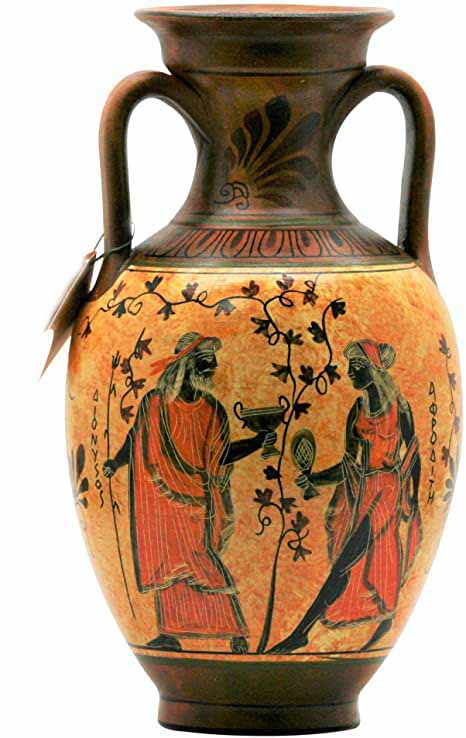
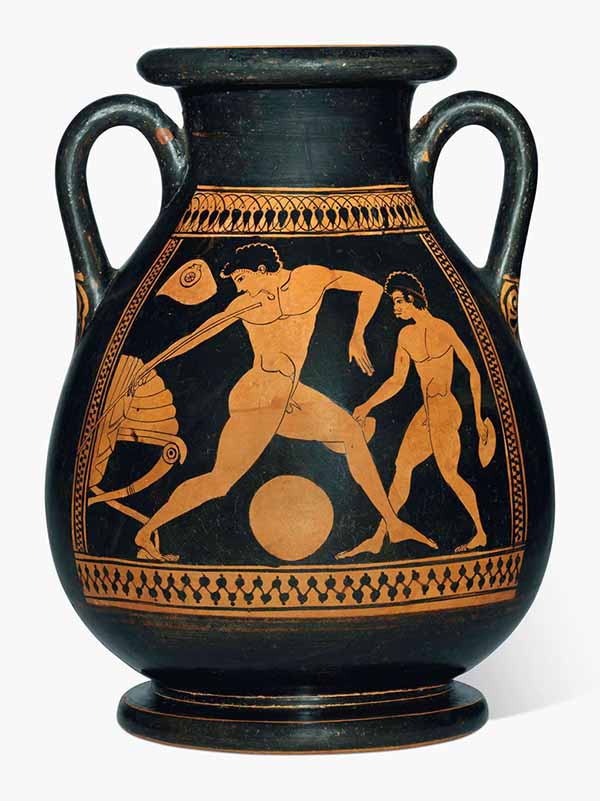
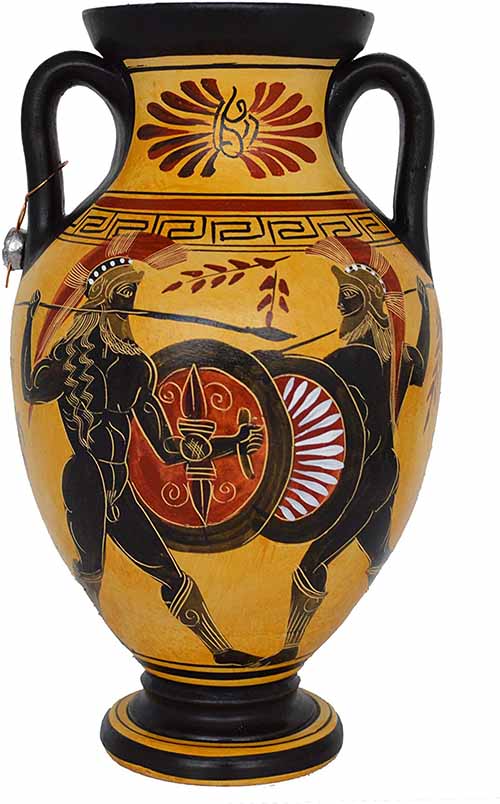
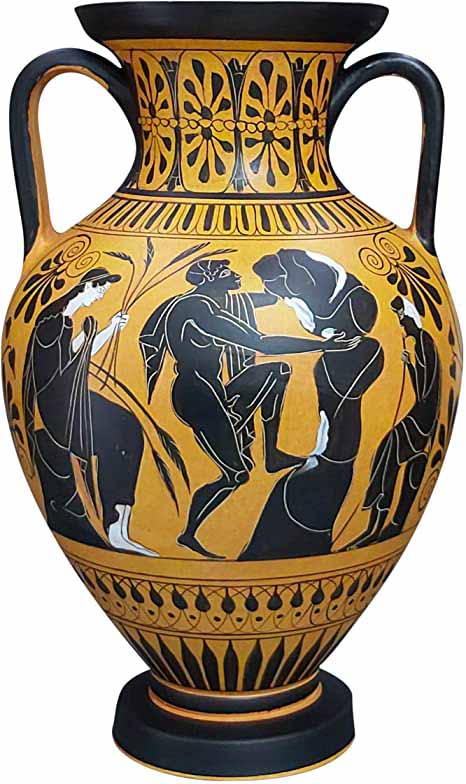
The Ancient Greeks made pottery for everyday use, not for display; the trophies won at games, such as the Panathenaic Amphorae (wine decanters), are the exception.
Most surviving pottery consists of drinking vessels such as amphorae, kraters (bowls for mixing wine and water), hydria (water jars), libation bowls, jugs and cups.
Painted funeral urns have also been found. Miniatures were also produced in large numbers, mainly for use as offerings at temples. In the Hellenistic period a wider range of pottery was produced, but most of it is of little artistic importance.
In earlier periods even quite small Greek cities produced pottery for their own locale. These varied widely in style and standards. Distinctive pottery that ranks as art was produced on some of the Aegean islands, in Crete, and in the wealthy Greek colonies of southern Italy and Sicily.
By the later Archaic and early Classical period, however, the two great commercial powers, Corinth and Athens, came to dominate.
Their pottery was exported all over the Greek world, driving out the local varieties.
Pots from Corinth and Athens are found as far afield as Spain and Ukraine, and are so common in Italy that they were first collected in the 18th century as "Etruscan vases".
Many of these pots are mass-produced products of low quality. In fact, by the 5th century BC, pottery had become an industry and pottery painting ceased to be an important art form.The history of Ancient Greek pottery is divided stylistically into periods:
The range of colours which could be used on pots was restricted by the technology of firing: black, white, red, and yellow were the most common. In the three earlier periods, the pots were left their natural light colour, and were decorated with slip that turned black in the kiln.
The fully mature black-figure technique, with added red and white details and incising for outlines and details, originated in Corinth during the early 7th century BC and was introduced into Attica about a generation later; it flourished until the end of the 6th century BC.
The red-figure technique, invented in about 530 BC, reversed this tradition, with the pots being painted black and the figures painted in red. Red-figure vases slowly replaced the black-figure style. Sometimes larger vessels were engraved as well as painted.
During the Protogeometric and Geometric periods, Greek pottery was decorated with abstract designs.
In later periods, as the aesthetic shifted and the technical proficiency of potters improved, decorations took the form of human figures, usually representing the gods or the heroes of Greek history and mythology.
Battle and hunting scenes were also popular, since they allowed the depiction of the horse, which the Greeks held in high esteem. In later periods erotic themes, both heterosexual and male homosexual, became common.
Greek pottery is frequently signed, sometimes by the potter or the master of the pottery, but only occasionally by the painter.
Hundreds of painters are, however, identifiable by their artistic personalities: where their signatures haven't survived they are named for their subject choices, as "the Achilles Painter", by the potter they worked for, such as the Late Archaic "Kleophrades Painter", or even by their modern locations, such as the Late Archaic "Berlin Painter".
Sculpture is by far the most important surviving form of Ancient Greek art, although only a small fragment of Greek sculptural output has survived. Greek sculpture, often in the form of Roman copies, was immensely influential during the Italian Renaissance, and remained the “classic” model for European sculpture until the advent of modernism in the late 19th century.
The Greeks decided at a very early period that the human form was the most important subject for artistic endeavor.
Since they saw their gods as having human form, there was no distinction between the sacred and the secular in art - the human body was both secular and sacred.
A male nude could just as easily be Apollo or Herakles or that year's current Olympic boxing champion. In the Archaic Period the most important sculptural form was the kouros (plural kouroi), the standing male nude.
The kore (plural korai), or standing female figure, was also common, but since Greek society did not permit the public display of female nudity until the 4th century BC, the kore is considered to be of less importance in the development of sculpture.
As with pottery, the Greeks did not produce sculpture merely for artistic display.
Statues were commissioned either by aristocratic individuals or by the state, and used for public memorials, as offerings to temples, oracles and sanctuaries (as is frequently shown by inscriptions on the statues), or as markers for graves.
In the Archaic period, statues were never intended to be representations of actual individuals. They were depictions of an ideal - beauty, piety, honor or sacrifice.
They were always depictions of young men, ranging in age from adolescence to early maturity, even when placed on the graves of (presumably) elderly citizens. Kouroi were all stylistically similar. Gradations in the social importance of the person commissioning the statue were indicated by size rather than artistic innovation.
In the Classical period there was a revolution in Greek statuary, usually associated with the introduction of democracy and the end of the aristocratic culture associated with the kouroi. The Classical period saw changes in both the style and function of sculpture.
Poses became more naturalistic (see the Charioteer of Delphi for an example of the transition to more naturalistic sculpture), and the technical skill of Greek sculptors in depicting the human form in a variety of poses greatly increased.
From about 500 BC statues began to depict real people.
The statues of Harmodius and Aristogeiton set up in Athens to mark the overthrow of the tyranny were said to be the first public monuments to actual people.
In this period, statuary was put to wider uses.
The great public buildings of the Classical era, such as the Parthenon in Athens, created the need for decorative statuary, particularly to fill the triangular fields of the pediments: a difficult aesthetic and technical challenge that did much to stimulate sculptural innovation.
Unfortunately such sculptures survive only in fragments, the most famous of which are the Parthenon Marbles, now mostly in the British Museum.
Funeral statuary evolved during this period from the rigid and impersonal kouros of the Archaic period to the highly personal family groups of the Classical period.
These monuments are commonly found in the suburbs of Athens, which in ancient times were cemeteries on the outskirts of the city.
Although some of them depict "ideal" types - the mourning mother, the dutiful son - they increasingly depicted real people, typically showing the departed talking his dignified leave from his family. They are among the most intimate and affecting remains of the Ancient Greeks.
In the Classical period for the first time we know the names of individual sculptors. Phidias oversaw the design and building of the Parthenon. Praxiteles made the female nude respectable for the first time in the Late Classical period (mid 4th century): his Aphrodite of Knidos, which survives in copies, was said by Pliny to be the greatest statue in the world.
The greatest works of the Classical period, the Statue of Zeus at Olympia and the Statue of Athena Parthenos (both executed by Phidias or under his direction), are lost, although smaller copies and good descriptions of both still exist. Their size and magnificence prompted emperors to seize them in the Byzantine period, and both were removed to Constantinople, where they were later destroyed in fires.
The transition from the Classical to the Hellenistic period occurred during the 4th century. Following the conquests of Alexander the Great (336 BC to 323 BC), Greek culture spread as far as India, as revealed by the excavations of Ai-Khanoum in eastern Afghanistan, and the civilization of the Greco-Bactrians and the Indo-Greeks. Greco-Buddhist art represented a syncretism between Greek art and the visual expression of Buddhism.
Thus Greek art became more diverse and more influenced by the cultures of the peoples drawn into the Greek orbit. In the view of most art historians, it also declined in quality and originality; this, however, is a subjective judgement which artists and art-lovers of the time would not have shared.
New centers of Greek culture, particularly in sculpture, developed in Alexandria, Antioch, Pergamum, and other cities. By the 2nd century the rising power of Rome had also absorbed much of the Greek tradition - and an increasing proportion of its products as well.
During this period sculpture became more and more naturalistic. Common people, women, children, animals and domestic scenes became acceptable subjects for sculpture, which was commissioned by wealthy families for the adornment of their homes and gardens. Realistic portraits of men and women of all ages were produced, and sculptors no longer felt obliged to depict people as ideals of beauty or physical perfection.
At the same time, the new Hellenistic cities springing up all over Egypt, Syria, and Anatolia required statues depicting the gods and heroes of Greece for their temples and public places. This made sculpture, like pottery, an industry, with the consequent standardization and some lowering of quality. For these reasons many more Hellenistic statues have survived than is the case with the Classical period.
Some of the best known Hellenistic sculptures are the Winged Victory of Samothrace (2nd or 1st century BC), the statue of Aphrodite from the island of Melos known as the Venus de Milo (mid 2nd century BC), the Dying Gaul (about 230 BC), and the monumental group Laocoon and his Sons (late 1st century BC).
All these statues depict Classical themes, but their treatment is far more sensuous and emotional than the austere taste of the Classical period would have allowed or its technical skills permitted.
Hellenistic sculpture was also marked by an increase in scale, which culminated in the Colossus of Rhodes (late 3rd century), which was the same size as the Statue of Liberty. The combined effect of earthquakes and looting have destroyed this as well as other very large works of this period.
Phidias (or Pheidias) son of Charmides, (c. 490 BC-c. 430 BC) was an ancient Greek sculptor, universally regarded as the greatest of Greek sculptors.
Phidias designed the towering statues of the goddess Athena in the Parthenon in Athens and the colossal seated Statue of Zeus at Olympia in the 5th century BC. These works were apparently commissioned by Pericles in 447 BC.
We have varying accounts of his training. Hegias of Athens, Ageladas of Argos, and the Thasian painter Polygnotus, have all been regarded as his teachers.
In favor of Ageladas it may be said that the influence of the many Dorian schools is certainly to be traced in some of his work. Of his life we know little apart from his works.
Of his death we have two discrepant accounts. According to Plutarch he was made an object of attack by the political enemies of Pericles, and died in prison at Athens.
According to Philochorus, as quoted by a scholiast on Aristophanes, he fled to Elis, where he made the great statue of Zeus for the Eleans, and was afterwards put to death by them. For several reasons the first of these tales is preferable.
Plutarch gives in his Life of Pericles a charming account of the vast artistic activity which went on at Athens while that statesman was in power. He used for the decoration of his own city the money furnished by the Athenian allies for defence against Persia: it is very fortunate that after the time of Xerxes Persia made no deliberate attempt against Greece. "In all these works," says Plutarch, "Pheidias was the adviser and overseer of Pericles."
Pheidias introduced his own portrait and that of Pericles on the shield of his Parthenos statue. And it was through Pheidias that the political enemies of Pericles struck at him. It thus abundantly appears that Pheidias was closely connected with Pericles, and a ruling spirit in the Athenian art of the period. But it is not easy to go beyond this general assertion into details.
It is important to observe that in resting the fame of Pheidias upon the sculptures of the Parthenon we proceed with little evidence. No ancient writer ascribes them to him, and he seldom, if ever, executed works in marble. What he was celebrated for in antiquity was his statues in bronze or gold and ivory.
If Plutarch tells us that he superintended the great works of Pericles on the Acropolis, this phrase is very vague. On the other hand, inscriptions prove that the marble blocks intended for the pedimental statues of the Parthenon were not brought to Athens until 434 BC, which was probably after the death of Pheidias.
And there is a marked contrast in style between these statues and the certain works of Pheidias. It is therefore probable that most if not all of the sculptural decoration of the Parthenon was the work of pupils of Pheidias, such as Alcamenes and Agoracritus, rather than his own.
The earliest of the great works of Pheidias were dedications in memory of Marathon, from the spoils of the victory. At Delphi he erected a great group in bronze including the figures of Apollo and Athena, several Attic heroes, and Miltiades the general. On the Acropolis of Athens he set up a colossal bronze image of Athena, which was visible far out at sea.
At Pellene in Achaea, and at Plataea he made two other statues of Athena, also a statue of Aphrodite in ivory and gold for the people of Elis.
But among the Greeks themselves the two works of Pheidias which far outshone all others, and were the basis of his fame, were the colossal figures in gold and ivory of Zeus at Olympia and of Athena Parthenos at Athens, both of which belong to about the middle of the 5th century.
Of the Zeus we have unfortunately lost all trace save small copies on coins of Elis, which give us but a general notion of the pose, and the character of the head. The god was seated on a throne, every part of which was used as a ground for sculptural decoration.
His body was of ivory, his robe of gold. His head was of somewhat archaic type: the Otricoli mask which used to be regarded as a copy of the head of the Olympian statue is certainly more than a century later in style.
Of the Athena Parthenos two small copies in marble have been found at Athens which have no excellence of workmanship, but have a certain evidential value as to the treatment of their original.It will be seen how very small is our actual knowledge of the works of Pheidias.
There are many stately figures in the Roman and other museums which clearly belong to the same school as the Parthenos; but they are copies of the Roman age, and not to be trusted in point of style.
Adolf Furtwangler proposed to find in a statue of which the head is at Bologna, and the body at Dresden, a copy of the Lemnian Athena of Pheidias; but his arguments (Masterpieces, at the beginning) are anything but conclusive. Much more satisfactory as evidence are some 5th century torsos of Athena found at Athens.
The very fine torso of Athena in the Ecole des Beaux Arts at Paris, which has unfortunately lost its head, may perhaps best serve to help our imagination in reconstructing a Pheidian original.Ancient critics take a very high view of the merits of Pheidias.
What they especially praise is the ethos or permanent moral level of his works as compared with those of the later "pathetic" school. Demetrius calls his statues sublime, and at the same time precise.
That he rode on the crest of a splendid wave of art is not to be questioned: but it is to be regretted that we have no morsel of work extant for which we can definitely hold him responsible.In 1958 archaeologists found the workshop at Olympia where Phidias assembled the gold-and-ivory Zeus.
There were still some shards of ivory at the site, and the base of a bronze drinking cup engraved "I belong to Phidias."
These sculptures are the greatest works of Greek art that have come down to modern times. A frieze ran like a decorative band around the top of the outer walls of the temple. It is 3 feet 3 inches high and 524 feet long. The subject is the ceremonial procession of the Panathenaic Festival. The figures represent gods, priests, and elders; sacrifice bearers and sacrificial cattle; soldiers, nobles, and maidens.
They stand out in low relief from an undetailed background. All are vividly alive and beautifully composed within the narrow band. The horses and their riders are particularly graceful. Their bodies
seem to press forward in rhythmical movement.
Around the outside of the portico above the columns were 92 almost square panels known as the metopes. Each panel depicted two figures in combat. In the east and west triangular pediments were groups of figures judged to be the world's greatest examples of monumental sculpture. The problem of composing figures in the triangular space of a low pediment was most skillfully solved.
The east pediment represented the contest of Athena and Poseidon over the site of Athens. The west pediment illustrated the miraculous birth of Athena out of the head of Zeus. The use of color and of bronze accessories enhanced the beauty of the pediment groups.
The "Aphrodite" of Melos, commonly known as the "Venus de Milo", is a beautiful marble statue now exhibited in the Louvre, Paris. Nothing is known of its sculptor. Experts date it between 200 and 100 BC.
The works of Phidias were followed by those of Praxiteles, Scopas, and Lysippus. What is believed to be an original work of Praxiteles, the statue 'Hermes with the Infant Dionysus' , is preserved in a Greek museum. This is the only statue that can be identified with one of the great Greek masters. Most of these sculptors are known only through copies of their work by Roman artists. The figure of Hermes as strong, active, and graceful, the face expressive of nobility and sweetness - is most beautiful.
The so-called Satyr or Faun of Praxiteles, which suggested Hawthorne's 'Marble Faun', is probably the work of another sculptor of the same school. Praxiteles' sculpture is less lofty and dignified than that of Phidias, but it is full of grace and charm. Scopas carried further the tendency to portray dramatic moods, giving his subjects an intense impassioned expression. Lysippus returned to the athletic type of Polyclitus, but his figures are lighter and more slender, combining manly beauty and strength. He was at the height of his fame in the time of Alexander the Great, who, it is said, wanted only Lysippus to portray him.
Two works of the period are the Dying Gaul, sometimes called
The 'Laocoon Group', which depicts a father and his sons crushed to death by serpents, illustrates the extremity of physical suffering as represented in sculpture.
A famous late Hellenistic statue is the 'Nike', or 'Winged Victory'.
The dramatic effect of her sweeping draperies and the swift movement of the figure are distinctive. In contrast to previous standing figures, this is an action pose, giving a sense of motion and wind at sea. The date of the statue has been disputed. At present it is usually placed between 250 and 180 BC. It was discovered in 1863 on the island of Samothrace and is now in the Louvre, Paris. Excavations on the same site in 1950 uncovered the right hand of the figure. The Greek government gave it to the Louvre in exchange for a frieze that once adorneda temple on the island.
Discus Thrower - circa 460 B.C.
The Pugilist - 1st century B.C. - The National Museum, Rome
The Naxian Sphynx - 560 B.C. - National Museum, Delphi
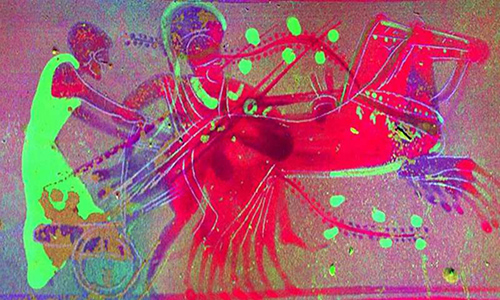
Under beams of X-rays, the colors of art become the colors of chemistry. The mysterious blacks, reds and whites of ancient Greek pottery can be read in elements iron, potassium, calcium and zinc- and art history may be rewritten. Under what they thought was a single coat, they found other instances of painting that the naked eye could not see.
Deciphering the elements of iconic pottery PhysOrg - March 29, 2011
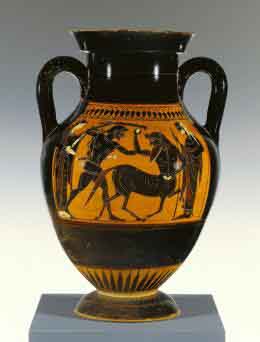
Attic pottery is the iconic red and black figure-pottery produced in ancient Greece from the 6th to the 4th centuries B.C. Like the vessel shown above from the collection of the J. Paul Getty Museum, such pottery required immense precision to produce, and the means by which craftsman created these vessels is still not completely understood.
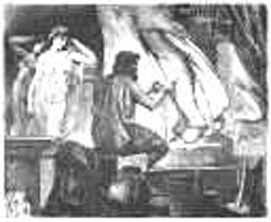
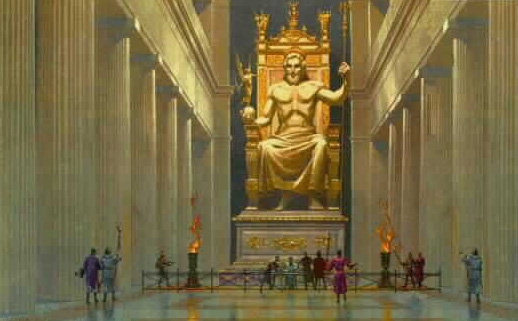
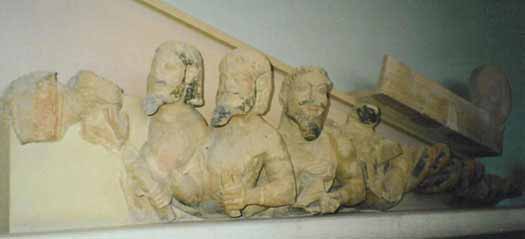
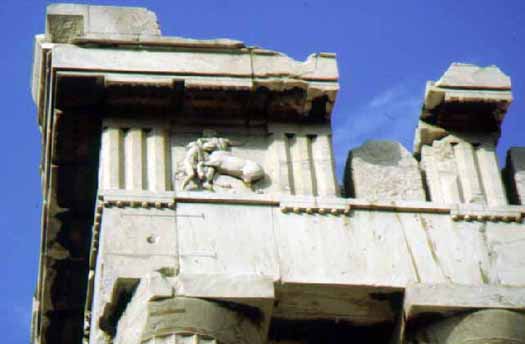
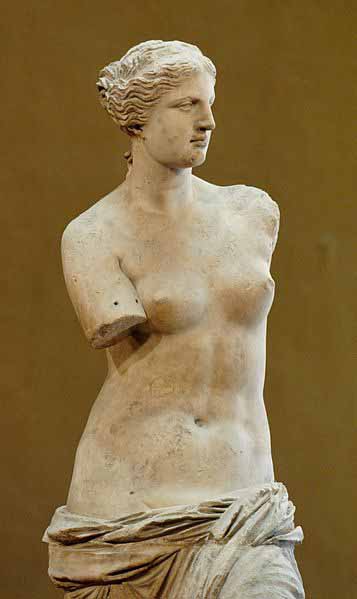
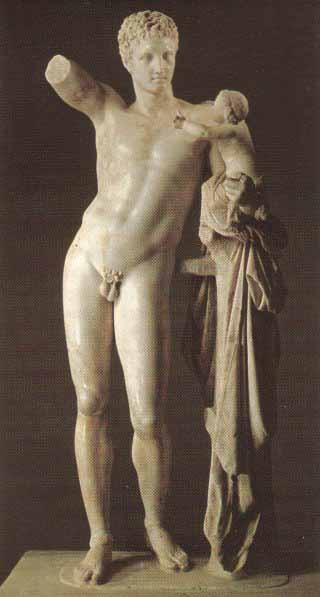
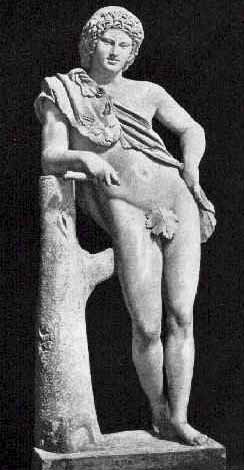
The period following the death of Alexander is known as 'Hellenistic'. Greek art lost much of its simplicity and ideal perfection of form, its serenity and restraint, but it gained in intensity of feeling and became more realistic.
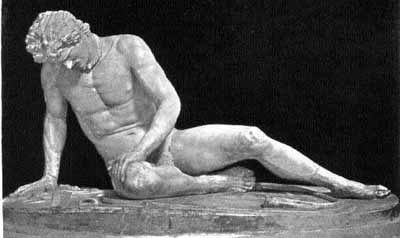
the 'Dying Gladiator', and the beautiful 'Apollo Belvedere'. 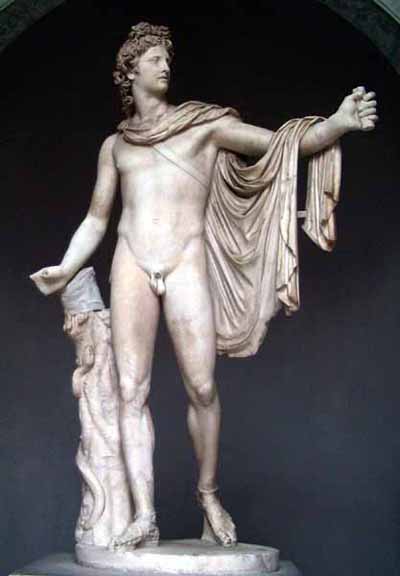
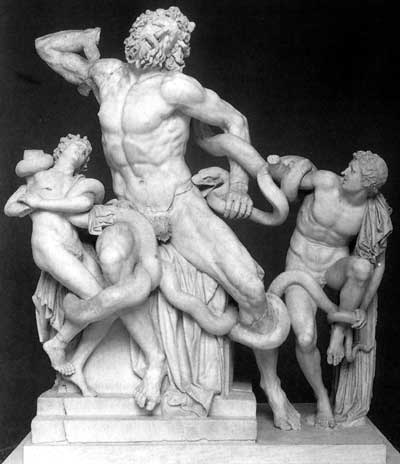

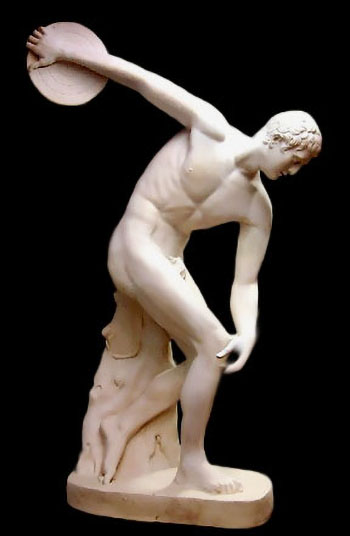
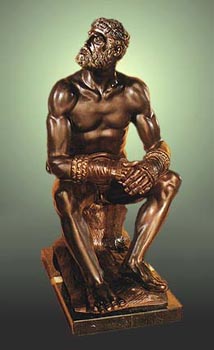
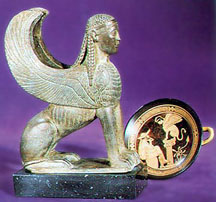
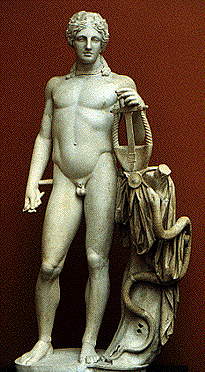
Torso of Apollo